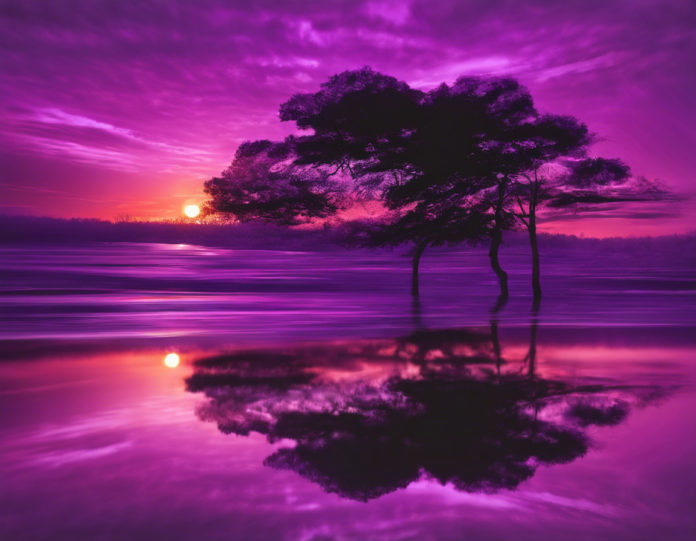There is something truly magical about witnessing a purple sunset. As the sun dips below the horizon, it paints the sky in a mesmerizing array of purples, pinks, oranges, and reds, creating a breathtaking scene that captivates and inspires. This natural phenomenon has long been a source of wonder and fascination for people around the world, drawing artists, poets, and dreamers alike to pause and appreciate the fleeting beauty of the moment.
The Science Behind a Purple Sunset
Sunsets are a result of the scattering of sunlight by the Earth’s atmosphere. When the sun is low on the horizon, the light has to pass through a thicker layer of the atmosphere, scattering the shorter wavelength colors like blue and green. This is why we often see hues of red, orange, and pink in a typical sunset.
But what creates that elusive purple hue in the sky? Well, it’s all about a phenomenon called “Rayleigh scattering.” This occurs when sunlight encounters molecules and small particles in the atmosphere that are roughly the same size as the wavelength of light. This scattering is most effective at shorter wavelengths, particularly blue and violet. When the sun is low on the horizon, the light passes through even more atmospheric particles, resulting in an increased scattering of blue and violet light, creating that beautiful purple color in the sky.
The Symbolism of a Purple Sunset
Purple is often associated with creativity, spirituality, and magic. It is a color that has long been linked to royalty and luxury, as well as to mystery and the unknown. Watching a purple sunset can evoke feelings of wonder, inspiration, and introspection. It is a reminder of the beauty and power of nature, and a moment to pause and reflect on the mysteries of the universe.
Capturing the Magic of a Purple Sunset
In the age of social media and instant photography, capturing the beauty of a purple sunset has never been easier. Whether you’re using a professional DSLR camera or simply your smartphone, there are a few tips and tricks to keep in mind:
-
Timing is key: Make sure you arrive at your chosen location well before the sun starts to set. This will give you time to set up your equipment and scout out the best vantage points for capturing the perfect shot.
-
Experiment with angles: Don’t be afraid to get creative with your compositions. Try shooting from different angles and perspectives to find the most captivating view of the sunset.
-
Use a tripod: To avoid blurry images, especially in low light situations, using a tripod can make a significant difference in the sharpness of your photos.
-
Adjust your settings: If you’re shooting with a DSLR camera, playing around with settings like aperture, ISO, and shutter speed can help you achieve the desired effect. For smartphone photographers, consider using apps that allow for manual adjustments.
-
Don’t forget to enjoy the moment: While capturing that perfect shot is important, don’t forget to take a moment to simply immerse yourself in the beauty of the sunset. Sometimes the most memorable moments are those we experience fully present, without the filter of a camera lens.
The Spiritual Meaning of a Purple Sunset
In many cultures and spiritual traditions, the color purple holds significant symbolism. It is often associated with the crown chakra, which is believed to be the center of spirituality and enlightenment. Watching a purple sunset can be a deeply spiritual experience for some, a moment of connection with the divine and a reminder of the transcendental nature of the universe.
The Artistic Inspiration of a Purple Sunset
Artists throughout history have been inspired by the beauty of sunsets, using them as subjects for paintings, poems, and music. The unique palette of colors in a purple sunset offers a wealth of inspiration for creative expression. Whether through the stroke of a brush on canvas, the scribble of a pencil on paper, or the notes of a musical composition, the beauty of a purple sunset can be immortalized in art for generations to come.
Embracing the Healing Power of a Purple Sunset
In recent years, the practice of environmental psychology has gained traction, exploring the ways in which our environment impacts our well-being. Studies have shown that exposure to natural beauty, such as sunsets, can have a profound impact on our mental and emotional health. Taking the time to watch a purple sunset can be a form of self-care, a moment of respite from the stresses of daily life, and a source of healing for the soul.
Frequently Asked Questions (FAQs)
- Why are some sunsets purple?
-
Sunsets appear purple due to a phenomenon called Rayleigh scattering, where shorter wavelength colors like blue and violet are scattered in the atmosphere.
-
What causes the purple color in the sky during a sunset?
-
The purple color in the sky during a sunset is a result of increased scattering of blue and violet light as the sun is low on the horizon.
-
Is it rare to see a purple sunset?
-
While purple sunsets are less common than those with reds and oranges, they can occur under the right atmospheric conditions.
-
What does a purple sunset symbolize?
-
Purple sunsets are often associated with creativity, spirituality, and magic, evoking feelings of wonder and inspiration.
-
How can I capture the beauty of a purple sunset in a photograph?
- To capture the beauty of a purple sunset, arrive early, experiment with angles, use a tripod, adjust your camera settings, and remember to enjoy the moment.
In conclusion, watching a purple sunset is a soul-stirring experience that connects us to the beauty and mystery of the natural world. Whether you’re an artist seeking inspiration, a spiritual seeker looking for connection, or simply a lover of beauty, taking the time to witness a purple sunset can be a transformative and healing experience. So next time the sun starts to dip below the horizon, pause for a moment, look up at the sky, and immerse yourself in the mesmerizing beauty of a purple sunset.












